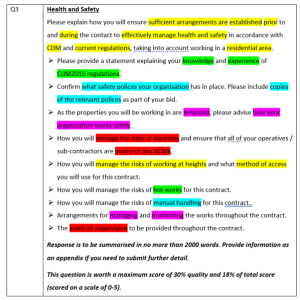Article Details
We break down some of the key principles of a good tender response, supporting you to gain high marks on quality.
Each of our bid writers completes dozens of bid and tender submissions every year, ensuring they have a comprehensive understanding of what a good tender response looks like as well as the content required to score marks with the authority.
When responding to a tender, you must:
- Address the question in full
- Outline your methods and solutions (the ‘what’ and ‘how’)
- Comply with the contract specification and other requirements from the authority
- Persuade the authority you are best positioned to deliver.
Understandably, balancing different kinds of content in a tender response can be challenging. With dozens of other organisations bidding for the same opportunity and the difference between a winning and losing tender often only a couple of marks, every word counts for a bid writer.
Plan your tender response before writing
When tendering for a contract, it can be tempting to jump straight into writing the tender response. This will be the most time- and resource-intensive element of the bid. However, it is critical to have a bid plan for each response prior to writing – minimising a haphazard or sloppy response that does not ‘flow’ or is missing crucial information.
Consequently, you should break down each question into constituent parts by highlighting each theme and topic to be covered in the tender response, ensuring nothing is missed or omitted.
The example below shows the bid planning approach followed by one our bid writers:

At this stage, you should also make sure to also assign enough words to address each of the topics you need to cover in the bid response. An ‘unbalanced’ tender response – for example, one that dedicates 500 words to one section, whilst only a couple of sentences to another – risks losing marks for failing to give comprehensive, persuasive detail.
Lastly, as with the example above, make sure to note any mandatory appendices and attachments which form the submission – in this instance, documented health and safety policies.
Introducing and closing a tender response
Good bid writing will be sharp, concise and easy to digest. Discursive introductions or closing paragraphs ‘recapping’ key points will not gain marks, and in fact may preclude you from using the assigned words more wisely elsewhere.
Introductions and conclusions should be short, snappy and meaningfully add value to the response. Examples of this could include:
- Demonstrating your experience through contracts or framework agreements for similar contracting authorities, e.g. nearby councils or housing associations
- Evidencing KPIs achieved and other statistics to underscore the efficacy of an approach – for example, customer service or quality in delivery
- Relevant accreditations or certifications pertinent to the topic at hand, such as an ISO 45001-accredited health and safety management system.
Strong opening and closing sections to a tender response will add value whilst avoiding a ‘jarring’ effect of jumping straight into content.
Guide the evaluator through your tender response
As with the example in the above section, most tender questions will expect bidders to address multiple topics and subjects within each tender response.
As such, it is important to effectively break up text in a tender response using the following:
- Headings and subheadings when moving from one topic to another and addressing multiple facets of the question
- Bullet points and numbered lists when describing a process or different benefits of a feature – minimising repetition or wasting words
- Tables for multiple subjects or data points, avoiding repetitive lists or bullet points and saving valuable space when working to tight word or page limits.
Equally, when highlighting a key feature or benefit, emphasising text to make it easy to identify is another beneficial strategy. This can be deployed when highlighting your particular process or a previous KPI which aligns with the authority’s requirements – ensuring the evaluator cannot miss it.
Do not neglect the ‘look and feel’ when responding to a tender
Lastly, although not a formal part of the evaluation process, bid formatting can have a positive impact on the evaluator. A clean, professional and well-formatted document will aid in the presentation of your tender response.
Some ‘quick wins’ for implementing a good look and feel when responding to a tender include:
- Aligning company brand colours in a tender response, such as using coloured text for headings and subheadings
- Images to substantiate content in a response, such as a screenshot of a job management system or before/after completion images
- Shading of text boxes, bulleted point lists and tables which may be better presented than in simple black and white
- Creating bespoke headers and footers with your own branding aligned with the contracting authority’s, underscoring a level of professionalism.
Prior to submission, review each tender response to ensure consistency across the bid. Our dedicated bid review service will also comment on the presentation of content – for instance, where adding an image could be more persuasive.
Our approach to writing a good tender response
Each of our bid and tender writers follows the same in-house style to producing consistent, high-quality content when responding to a tender. The success of our approach is proven across 15 years and more than 7,000 submissions supporting clients, with a fully auditable 85% success rate.
If you would like to learn more about our bid and tender services, contact our sales and marketing team today at info@executivecompass.co.uk or via telephone 0800 612 5563.
